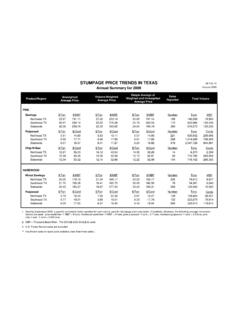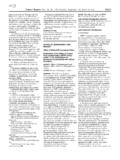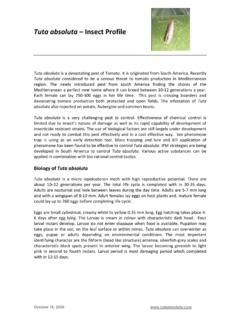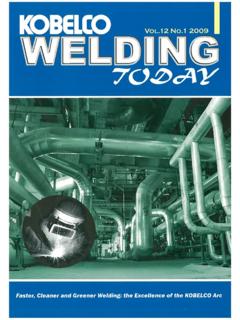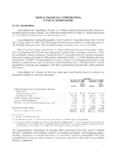Transcription of NAVAIR 01-1A-505 1 TO 1 1A TM 1 24 1
1 NAVAIR 01-1A-505 1. TO 1 1A 14. TM 1 1500 323 24 1. 15 september 2009 . TECHNICAL MANUAL. INSTALLATION AND REPAIR PRACTICES. VOLUME 1. AIRCRAFT ELECTRIC AND ELECTRONIC WIRING. This manual is one of a series of four volumes. For Navy Users Only This manual supersedes NAVAIR 01 1A 505 1 dated 1 september 2004 with Change 3 dated 15 May 2007. For Air Force Users Only This manual supersedes TO 1 1A 14 dated 1 september 2004 with Change 3 dated 15 May 2007. For Army Users Only This manual supersedes TM 1 1500 323 24 1 dated 1 september 2004 with Change 3 dated 15 May 2007. DISTRIBUTION STATEMENT A. Approved for public release. Distribution is unlimited. DESTRUCTION NOTICE - For unclassified, limited documents, destroy by any method that will prevent disclosure of contents or reconstruction of the document.
2 PUBLISHED BY DIRECTION OF THE COMMANDER, NAVAL AIR SYSTEMS COMMAND. 0801LP1101775. NAVAIR 01 1A 505 1. TO 1 1A 14. TM 1 1500 323 24 1 028 00. 15 september 2009 Page 1. PROTECTIVE DEVICES. INSTALLATION AND REPAIR PRACTICES. AIRCRAFT ELECTRIC AND ELECTRONIC WIRING. Reference Material Wire and Cable Stripping .. 009 00. Circuit Breaker, Aircraft, Trip Free, Push Pull, 1/2 20 Amp, Type 1, 55 to +121 Deg. C.. AS33201. Fuse, Limiter Type, Enclosed Link, 5 60 Amp, Aircraft .. MS28937. Fuse, Current Limiter Type, Aircraft .. MIL F 5372. Fuse, Instrument Type .. MIL F 23419. Fuseholders, Block Type, Aircraft .. MIL F 5373. Fuseholders, Extractor Post Type, Blown Fuse Indicating and Nonindicating .. MIL F 19207. Fuses; Instrument, Power and Telephone .. MIL F 15160. ARC Fault Circuit Breaker (AFCB), Aircraft, Trip Free Single Phase 115 VAC.
3 400 HZ Constant Frequency .. SAE AS 5692. Circuit Breaker ARP .. ARP1199. Alphabetical Index Subject Page No. Aircraft Circuit Breaker Protection .. 3. Extent of Circuit Protection .. 4. Practical Overcurrent Concepts .. 3. Arc Fault Sensing .. 3. Combined Current and Temperature Sensing .. 3. Current Sensing .. 3. Aircraft Components .. 8. Boots .. 8. Crimping .. 8. Insulation .. 8. Mounting Panels .. 8. Wires .. 8. Wire Gage .. 8. Aircraft Current Limiters .. 32. Applications of Current Limiters .. 32. Circuit Breaker Back-up Protection .. 32. Classification of Current Limiters .. 32. General .. 32. General Sizing .. 32. Maintenance .. 33. Part Numbering Scheme .. 32. Short Circuit Protection .. 32. Aircraft Fuse Protection .. 11. General .. 11. NAVAIR 01 1A 505 1. TO 1 1A 14.
4 TM 1 1500 323 24 1 028 00. 15 september 2009 Page 2. Classification of Circuit Breakers .. 4. Ampere Rating .. 6. Arc Fault Circuit Breakers .. 4. Definition .. 6. Electromagnetic Power Controller (EMPC) .. 4. Identification Markings .. 6. Magnetic .. 4. Orientation .. 6. Part Numbering Scheme for Circuit Breakers .. 6. Remote Control Circuit Breakers (RCCB) .. 4. Safety Factor .. 6. Solid Connections .. 6. Solid State Power Controller (SSPC) .. 5. Special Features .. 5. Terminals .. 6. Thermal .. 4. Thermal-Magnetic Assist .. 4. Trip Bars .. 6. Classification of Fuses .. 11. Current-Limiting .. 13. Normal .. 11. Part Numbering Scheme .. 13. Time-Delay .. 13. Very Fast Acting .. 13. Description .. 4. Introduction .. 4. Definition and Description .. 13. Fuses .. 14. Fuseholders.
5 32. Introduction .. 3. Protective Devices .. 3. Operation .. 7. As a Switch .. 7. Change in Trip Characteristics .. 7. Opening .. 7. Resetting .. 7. Teasing .. 7. Repair .. 8. Circuit Breaker Repair .. 8. Evaluation .. 8. Removal and Installation .. 8. Circuit Breaker Identification .. 11. Circuit Breaker Lockout/Deactivation .. 10. Circuit Breaker Permanent Removal .. 11. Inspection .. 9. Installation .. 9. Removal .. 8. Record of Applicable Technical Directives None NAVAIR 01 1A 505 1. TO 1 1A 14. TM 1 1500 323 24 1 028 00. 15 september 2009 Page 3. Support Equipment Required Nomenclature Part Designation Collar, Circuiut Breaker Deactivation (White) 12E2081 9. Kit, Safety Lock Circuit Breaker 296050020 1. O Ring, Safety Lock Circuit Breaker MS9068 111. Safety Lockout Ring, Circuit Breaker (Red) S4933959 531.
6 Safety Lock, 3/8 Circuit Breaker 296050002. Safety Lock, 7/16 Circuit Breaker 296050008. Safety Lock Sleeve, Circuit Breaker 296050009. Safety Lock Clip 296050018. Materials Required None 1. INTRODUCTION. breaker, but by a combination of devices, wire size, and routing. 2. This work package (WP) describes the circuit breaker, fuses and limiters for use in the circuitry of aerospace vehicles. 6. PRACTICAL OVERCURRENT CONCEPTS. There are two basic principles in use for the protection of electrical and electronic equipment from failures 3. PROTECTIVE DEVICES. Protective devices are caused by current overloads: items of electrical equipment such as circuit breakers, fuses, etc., installed in aircraft to protect the electrical 7. Current Sensing. The current sensing principle system against overloads caused by short circuits or other is found in devices such as magnetic or fully ambient faults.
7 Protective devices for wired-in equipment shall compensated circuit breakers. In some applications, be connected to the load side of the equipment power practical considerations make it necessary for the circuit breaker and wire to be in entirely different ambient switch (main circuit power disconnect). The protective temperatures. In this case it may be necessary to use device may be on the line side or the load side of the an ambient insensitive circuit breaker and apply it on equipment on-off switch. If possible, mount protective the basis of maximum temperature rise expected at any devices in junction boxes or protected areas. If this is point in the circuit. Increases in the ambient temperature not possible, and the devices are to be installed in around the circuit breaker will reduce its current trip locations where they may be subject to damage or where level.
8 The terminals may be dangerous to the personnel, provide 8. Combined Current and Temperature Sensing. a cover to go over the protective device. Some thermal circuit breakers not only anticipate thermal failures due to overcurrent, but also compensate for 4. A I R C R A F T CIRCUIT BREAKER variations in the ambient temperature. This compensation PROTECTION. helps the circuit breaker follow the changes in wire current carrying capacity due to ambient temperature. 5. A circuit breaker is used to help provide automatic These circuit breakers may be located in the same protection that will limit an electrical fault to a single ambient temperature as the wire. They are selected to match the thermal characteristics of the wire being circuit. It minimizes the danger of smoke and fire to protected.
9 Components. Its primary function, however, is to minimize the danger of smoke and fire to the conductors 9. Arc Fault Sensing. Thermal circuit breakers are (or cables) leading to and from components. It isolates designed to react to the heating effect of current carried the fault from the power source so that the non-faulted by wire; and to protect the wire insulation from thermal circuits can be kept functioning in a normal manner. damage. These protective devices are not designed to detect or react to the short duration of arcing faults This may not always be achieved by a single circuit NAVAIR 01 1A 505 1. TO 1 1A 14. TM 1 1500 323 24 1 028 00. 15 september 2009 Page 4. that typically occur outside (before approaching) the 15. THERMAL-MAGNETIC ASSIST. Thermal defined trip region, or Time versus Current curve, of circuit breakers may also include a magnetic assist the thermal circuit breakers.
10 Arc impedance can reduce mechanism used only on high current overloads. low voltage fault current magnitudes appreciably. AFCBs However, due to their operating principles, thermal combine active arc fault detection with thermal overload circuit breakers inherently produce less magnetic field protection into one package. The AFCB provides an interference than magnetic circuit breakers. equivalent level of thermal protection of existing thermal circuit breakers (typically qualified under AS58091), 16. MAGNETIC. Magnetic circuit breakers generally with the added ability to detect and react to arc fault operate using the solenoid principle, where a moveable conditions, thereby mitigating damage that will occur piece held with a spring may be moved by the magnetic to the wiring system by protracted arcing events.

